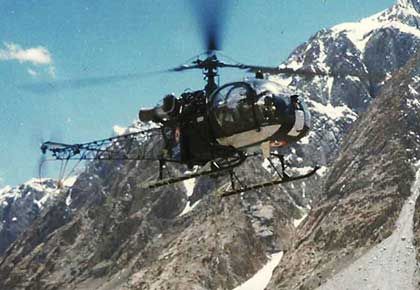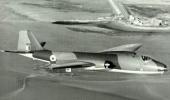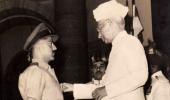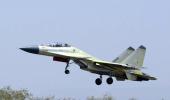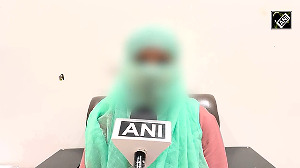'The intentions are clear as day!'
'Let India build the infrastructure, then they will claim the land and use the infrastructure to their benefit.'
Air Commodore Nitin Sathe (retd) speaks to IAF veterans who have flown in the Galwan Valley long before it became today's headlines.

Meet the Cheetah helicopter.
Without this glass bubble ensconced inside a see through maze of tubes and a set of noisy rotors, India's reach to the nooks and crannies of the unforgiving high mountains that separate us and the Chinese would not be possible at all.
In the last few days, we have heard blow by blow accounts of how things have panned out along the India-China divide.
Who plays an important part of transporting the essential supplies to these troops?
What is the reason for their high morale?
Who transports the casualties to the hospital for critical care?
Who is always on 'Hot Standby' whenever tensions run high?
The Cheetah, of course.
Yes, there are other bigger machines like the Mi-17 and the Dhruv (ALH), but due to its size and agility, the Cheetah can go almost everywhere and land almost anywhere.
Two Indian Air Force veterans give me a sense of what it is like to fly near the Line of Actual Control.

The 114 Helicopter Unit, located at Leh, has operated these machines in the Shyok and Nubra Valleys for as long as we have had Siachen, helping us to maintain vigil on the Chinese front.
The Indian Army also has Cheetah and ALH units operating in the area.
The Cheetah is one of the few machines which can lift its own empty weight; but the capacity inside the cabin is just enough to carry three persons stuck shoulder to shoulder.
However, the load carrying capacity decreases rapidly with altitude.
"In the glacier, on a good summer day, the machine is capable of lifting just 25 kg weight to the forward posts of Amar and Sonam," explains an army veteran who has clocked more than 1,000 hours in that sector alone.
The helicopter units operating in this area are tasked to tend to the requirements of the deployed troops in the Siachen Glacier for which they operate from the Siachen Base Camp located just north of Khardungla, the highest motorable pass in the world which lies north of Leh.
Other than tasks specific to the glacier, they also meet all the requirements of the other military and paramilitary units deployed all over the Ladakh sector.

What was it like to fly the Cheetah in the mountains of Ladakh along the LAC?
Meet Air Commodore Rahul Anand Maslekar (retd).
The Indian Air Force veteran did two tenures at 114 HU; the first one as a youngster, when the Siachen issue had just surfaced in 1983 and then in 1995, as the flight commander of the unit, in charge of all the operational activities.
Anyone who flies in this sector remembers the area like the back of his hand as Air Commodore Maslekar proved.
He was so clear about the topography of the area. Without looking at a map, he described the routes and orientation of valleys as if he had just come back from there yesterday.
"Galwan?" says the air commodore, "We knew where it was. We saw the valley as we flew from Darbuk to Daulat Beg Oldi during regular missions."
"In their familiarisation sorties with experienced pilots, the young pilots were always warned to avoid going anywhere into the Galwan Valley," he remembers.
"'Don't try to enter Galwan, it is too close to the LAC', they used to tell us," the veteran helicopter pilot adds.
"As such, there were no troops in that valley, so there was no occasion to go and drop some loads there or evacuate anyone from the Galwan Valley," the air commodore explains.
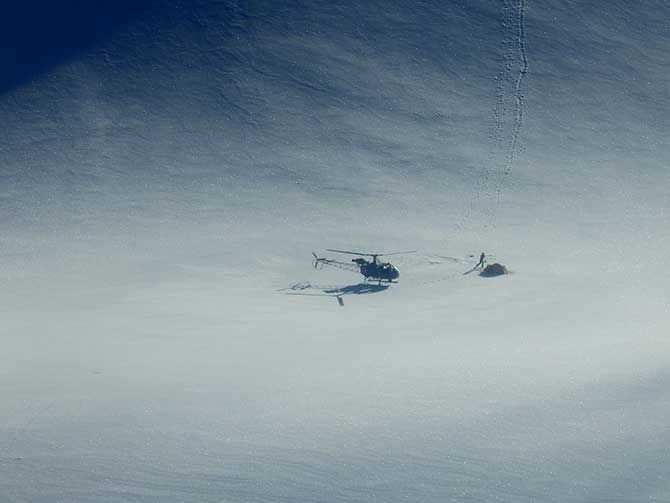
The sorties in the Siachen were short and sweet, but involved a rapid climb to the posts which was taxing both on man and machine.
"We managed 5, 6 missions per aircraft on a daily basis in the glacier," says Air Commodore Maslekar. "On the other hand, the sorties in the Shyok Valley were relatively relaxed, but of long duration."
"This led to other problems," the IAF veteran recalls. "We had just two oxygen cylinders per pilot inside the small cabin and nowhere to get them filled or replaced enroute."
"So rationing was the only answer; sometimes it would lead us to actually see the effects of hypoxia-breathlessness, tingling sensations etc, things we had read in aviation medicine classes," he adds.
To save oxygen, the oxygen was consumed like a hookah.
"The mask was kept on our thighs in flight; as and when we wanted a swig of oxygen, we put it to our face and filled our lungs," the air commodore remembers.
This system was the only way to be conservative in oxygen consumption; had the pilots attached the masks to their faces through the flight, they would not have been able to do even half the mission.
"The sorties were quite boring otherwise, since there wasn't much map reading to do once we entered the required valley. We knew the place backwards and didn't require a map to navigate," Air Commodore Maslekar remembers.
A good pastime for the pilots was to watch for the ibex, double humped camels and Himalayan wolves.
"No names, but there were some adventurous amongst us who chased the wolves along the river valleys, flying close to the ground!" exclaims the IAF veteran.

"We had to fly with primitive flying clothing which has improved over the years. It was a good 10 odd kg extra weight to carry, but it was mandatory to wear this winter clothing for survival should we have a crash or had to force land the helicopter due to a technical malfunction," says Air Commodore Maslekar.
"In those times, we flew single aircraft missions," the air commodore points out, "later, for reasons of flight safety, it was changed to flying with a buddy always."
All helicopter missions in the area are generally flown at an average height of 15,000 to 18000 feet which in itself was quite exhausting.
This is pretty strenuous even for a person who has been through acclimatisation in Leh.
As you came home to rest, you were dead tired and often landed up with headaches associated with hypoxia.
Ear pain also was common.
"A pilot spending one tenure flying at these altitudes greys faster. It also takes a toll on his memory retention," says Air Commodore Maslekar whose memory, despite his dual tenures in the area, is pitch perfect.

Hearing the helicopter coming into land at a post in the area is music to the ears of a soldier.
He awaits letters and parcels from his family as well as fresh rations, which are a welcome change from eating tinned stuff all the time.
"While we carried out mail courier sorties or to pick up a casualty, a cup of tea in a steel glass covered with camouflage cloth always awaited us at the helipad," the air commodore remembers.
"Hot gulab jamuns and pakoras were served whatever time of the day you landed at these forward posts," he recalls. "The boys (Indian Army soldiers) would be very happy if we had the savouries, sweets and the tea, and we never disappointed them."
Having flown extensively in areas like these myself, the smell of smoke and kerosene (that cling onto clothes as well as to what was served) always takes me back to a forward post in the Himalayas.
The smell and taste didn't matter at all since it was served with so much of affection.
Every helicopter pilot will remember the magazines and newspapers that were carried for the troops.
Even old newspapers wrapped around items delivered were a source of reading for these men, I remember.
The Cheetah and I have had a special relationship too.
The best and most adventurous part of my flying in the IAF was done on this wondrous machine in the hills of the central sector.
I can say with confidence that the Cheetah really belonged to the high altitudes and loved the mountains as if it were its home.
If I had to choose a helicopter to fly amongst the many sophisticated ones I have flown, I would still choose the small, agile and basic Cheetah!

Wing Commander Raju Srinivasan, another IAF veteran, was Air Commodore Maslekar's senior during his time at 114 HU.
"The pilots flew the Chetak -- the Alouette-III -- before the much lighter Cheetah was inducted into the glacier. The Chetak would barely reach any worthwhile altitude in the area," remembers the wing commander.
"We used the Chetak to go from the plains to Leh after which we got into the Cheetahs to do serious business," he recalls.
"Sometimes, when there was a shortage of Cheetahs, we used the Chetaks to do the LAC sector in the initial days, but its performance was pretty poor," he says.
"In my 5+ years of flying in the Shyok Valley," says Wing Commander Srinivasan, "we never mentioned or entered the Galwan Valley."
"The confluence of the Galwan/Shyok had an uninhabited place called Yargulak (meaning caravan halting ground in Tibetan). There was no helipad in this valley till 1995 when I flew in this area," the wing commander says.
"My reading is that China claims the Galwan Valley was theirs right till the confluence of the Shyok River. And our road to Daulat Beg Oldi is on the banks of the Shyok. When this road was built in the last 10 years, there was no objection from the Chinese. And now that the road has been commissioned, the Chinese come to claim the Galwan-Shyok axis!!" exclaims Wing Commander Srinivasan.
"The intentions are clear as day! Let India build the infrastructure, then they will claim the land and use the infrastructure to their benefit," says the IAF veteran.
"We must deny Galwan and any other fresh claims even if it means War!" says the long retired wing commander who, it appears, would readily don his helmet and climb into the cockpit for a mission.
Air Commodore Nitin Sathe (retd), a veteran helicopter pilot, retired from the Indian Air Force in February after 35 distinguished years of service.
Air Commodore Sathe served as the station commander at the IAF's Jammu air base from 2010 to 2012.
Production: Ashish Narsale/Rediff.com
